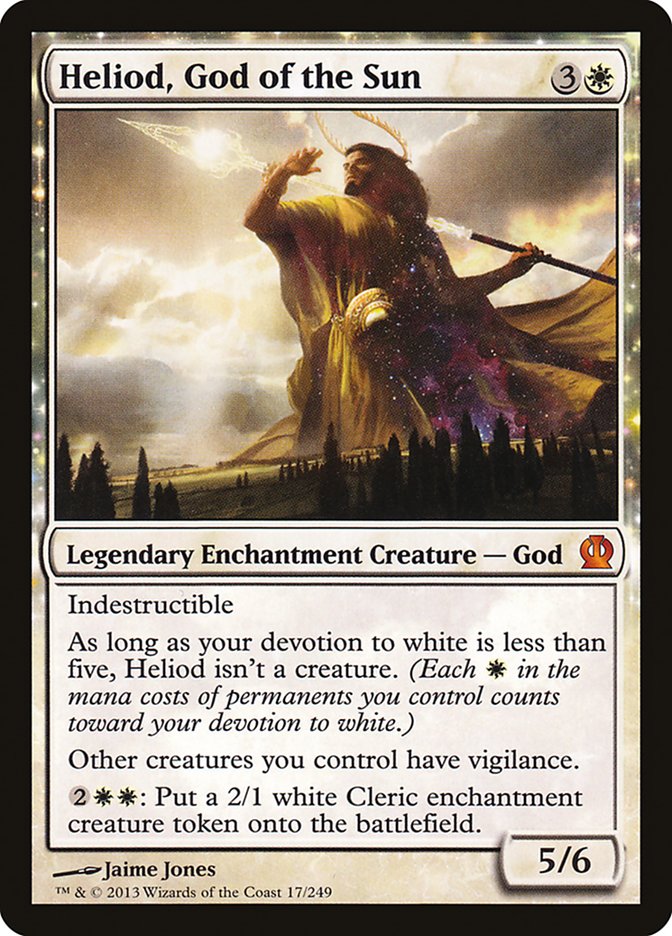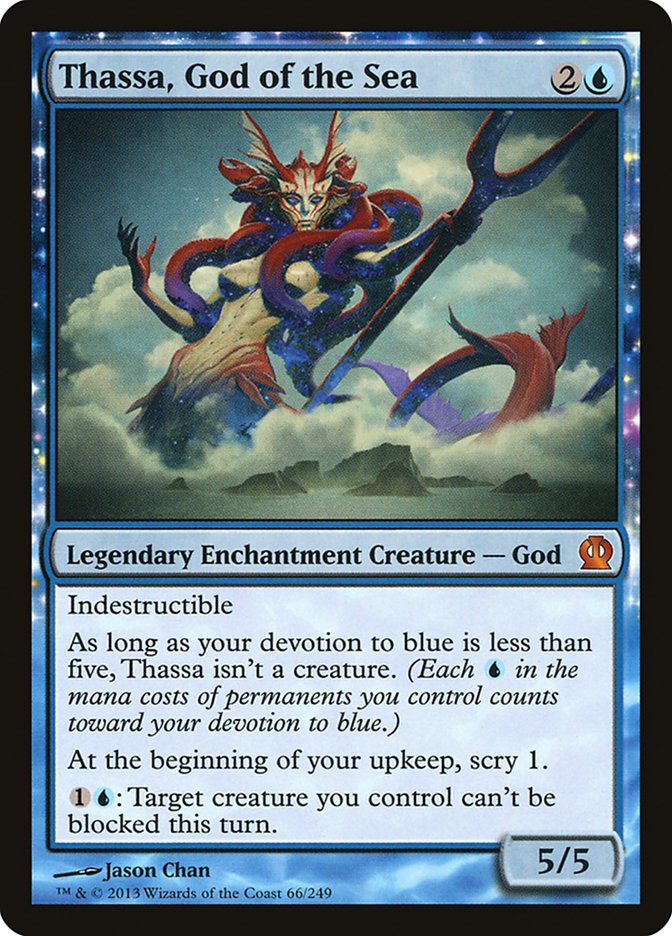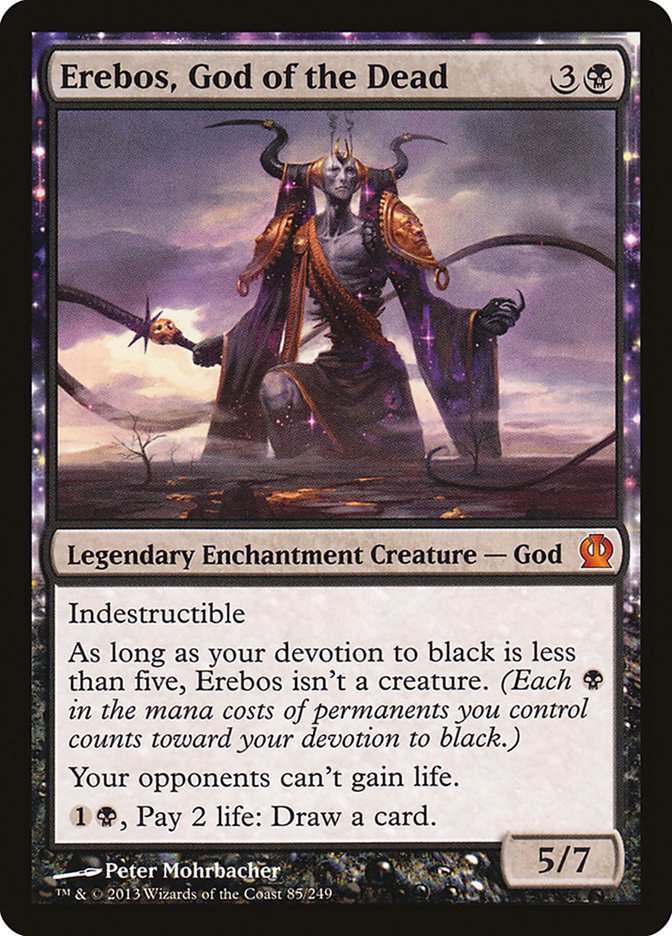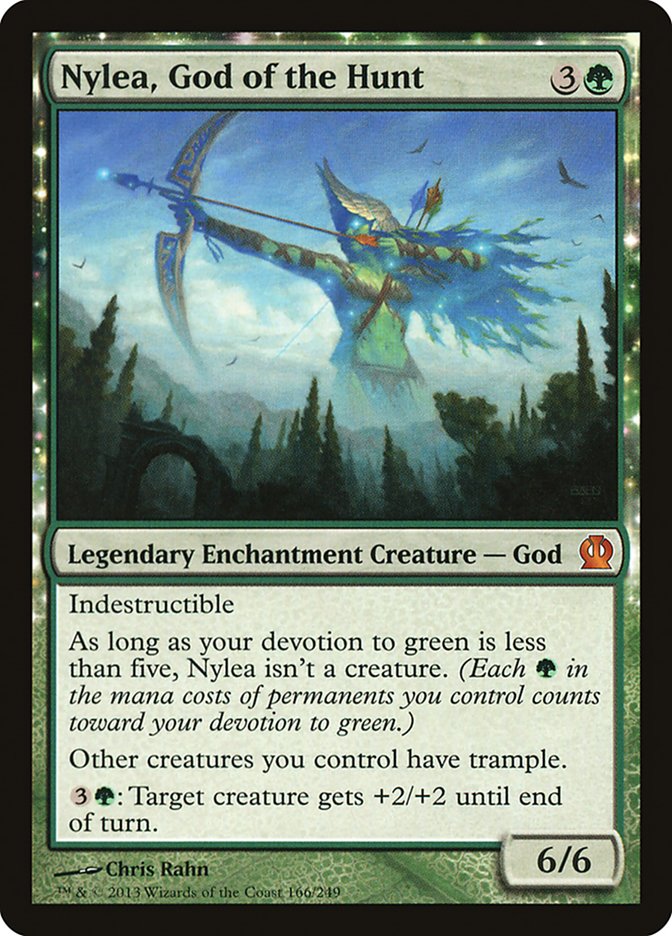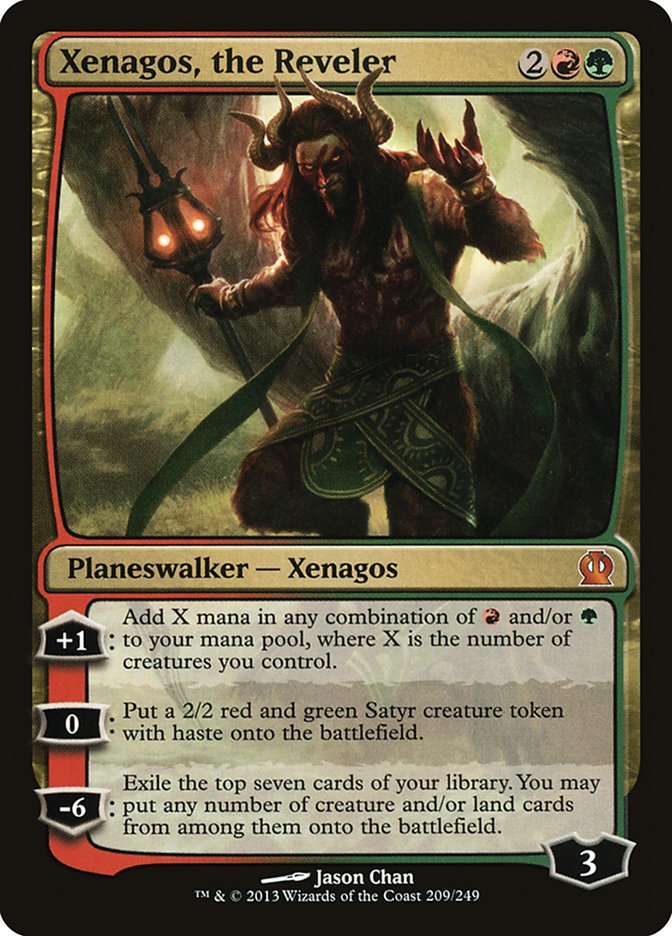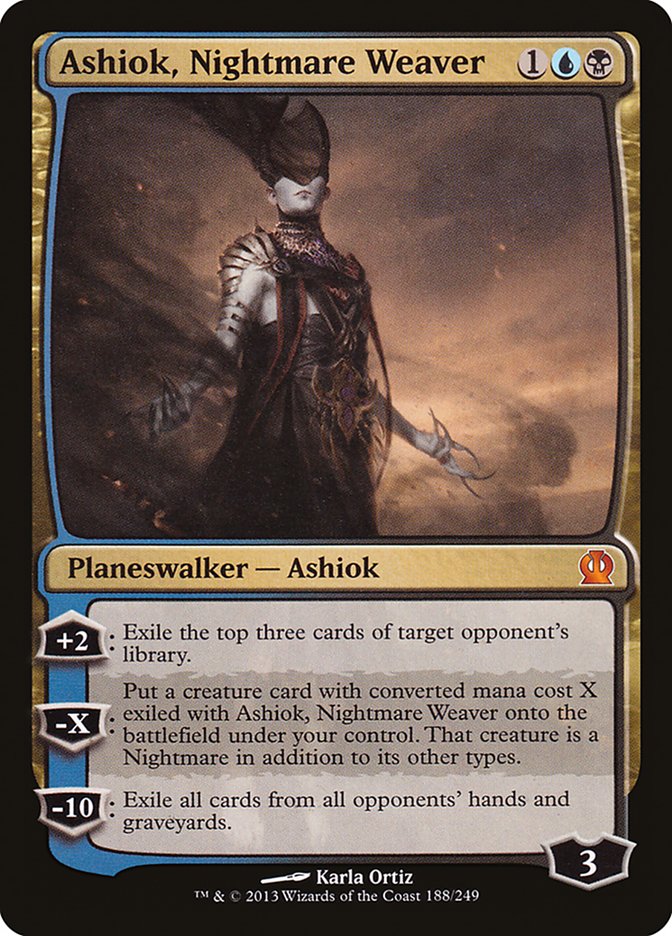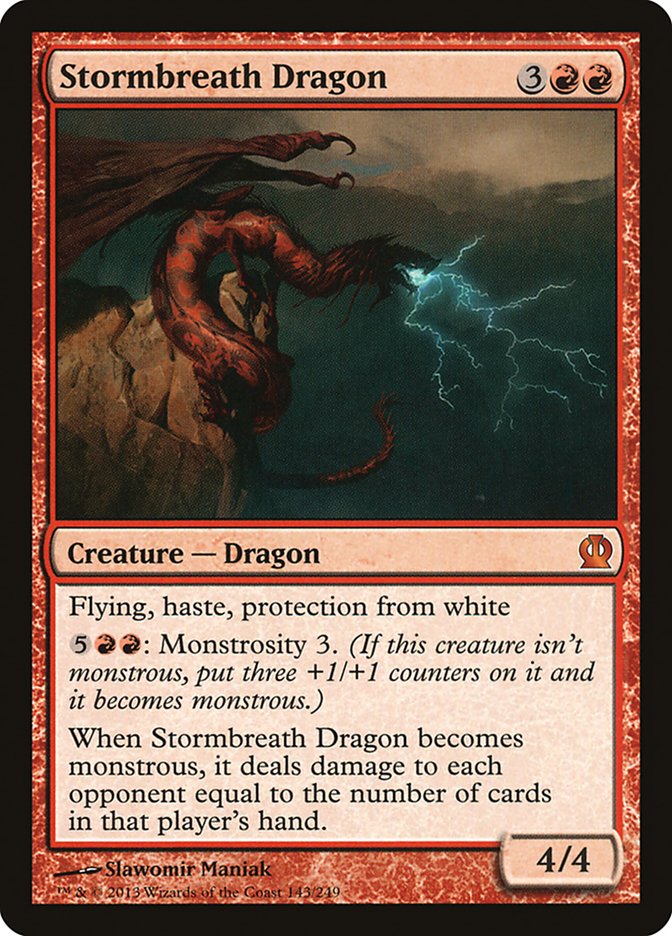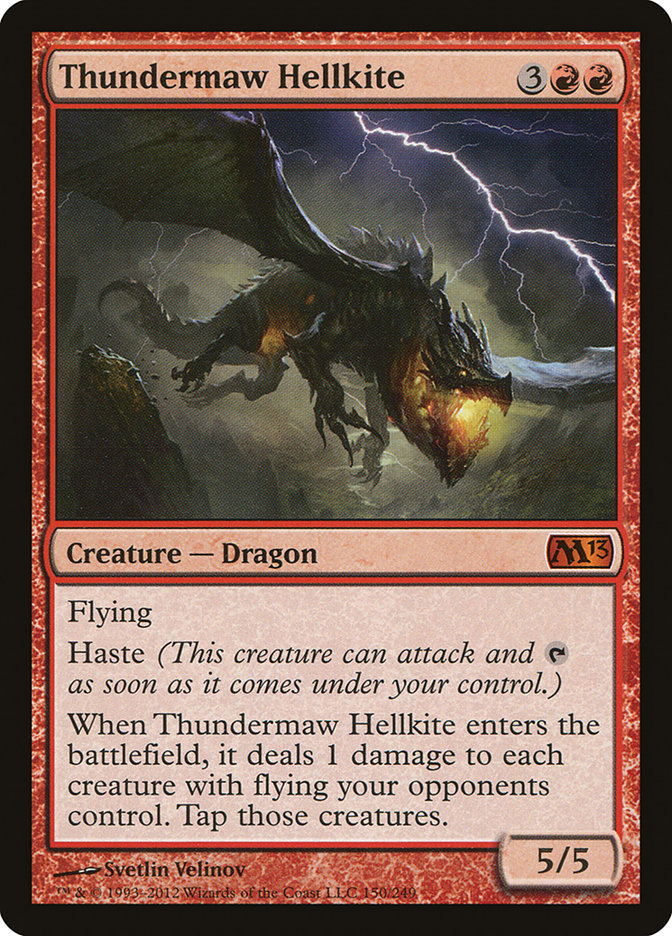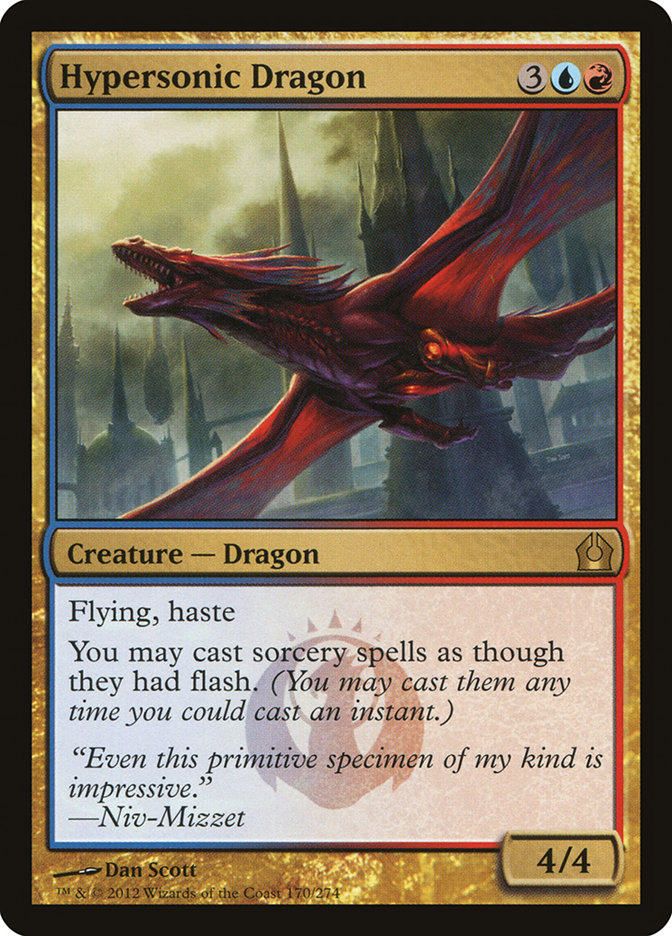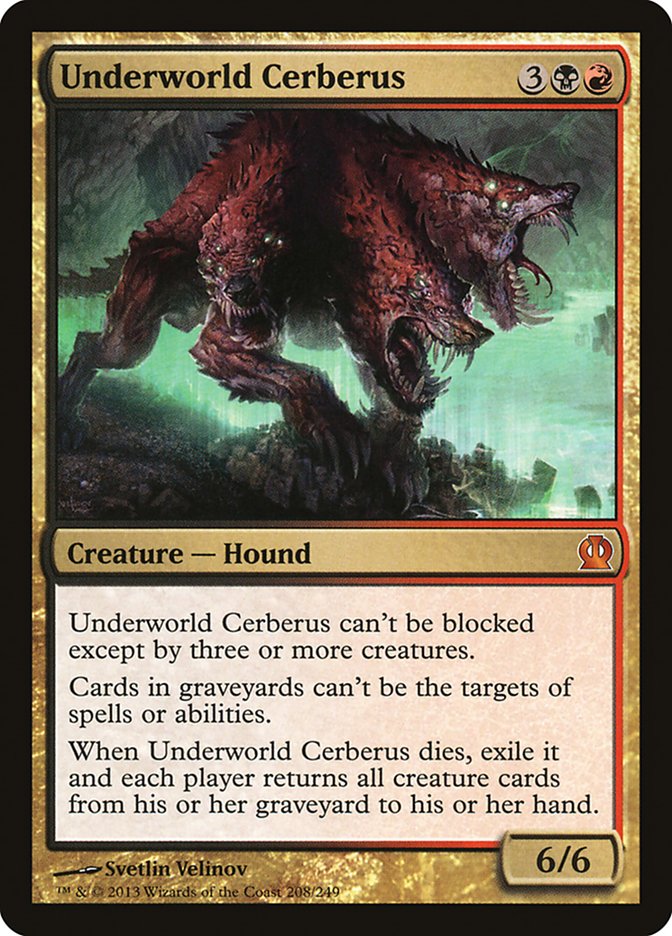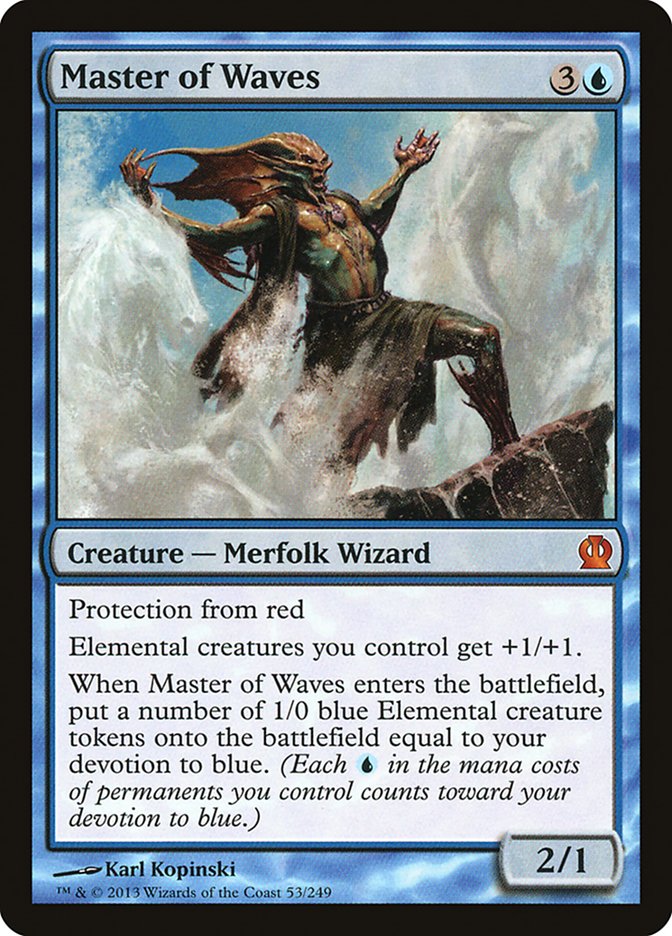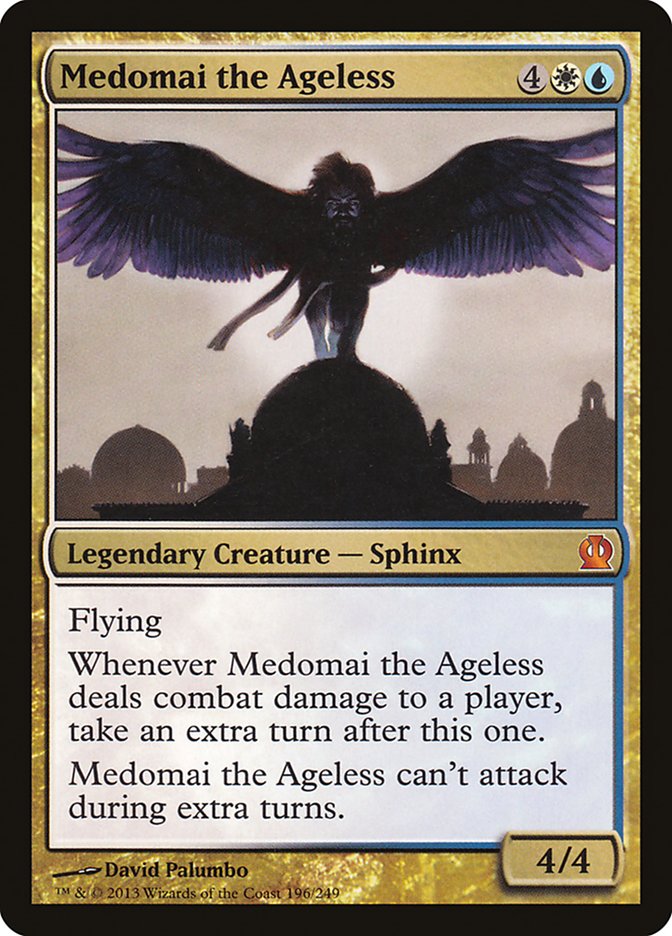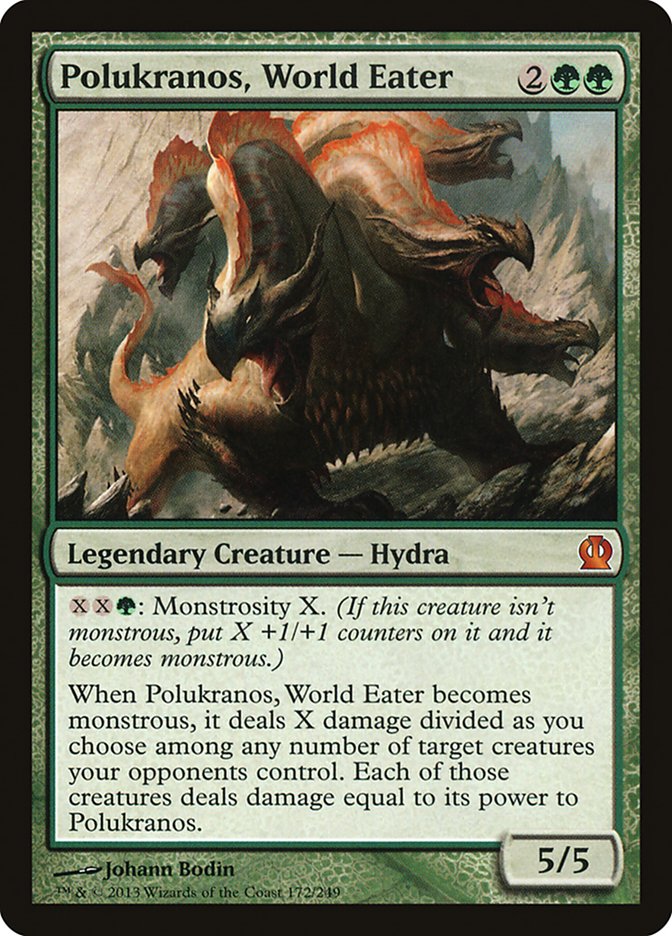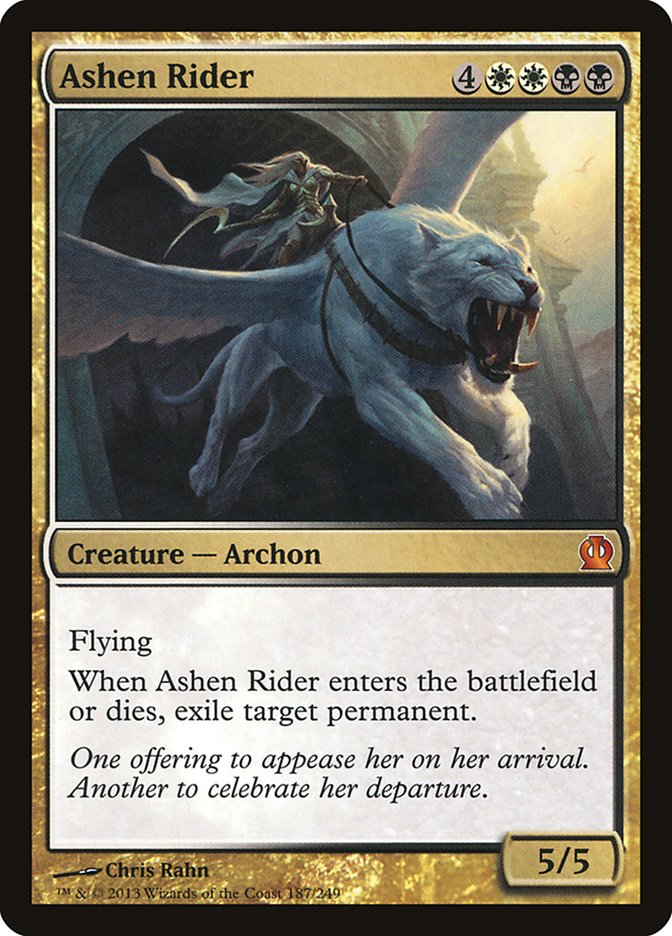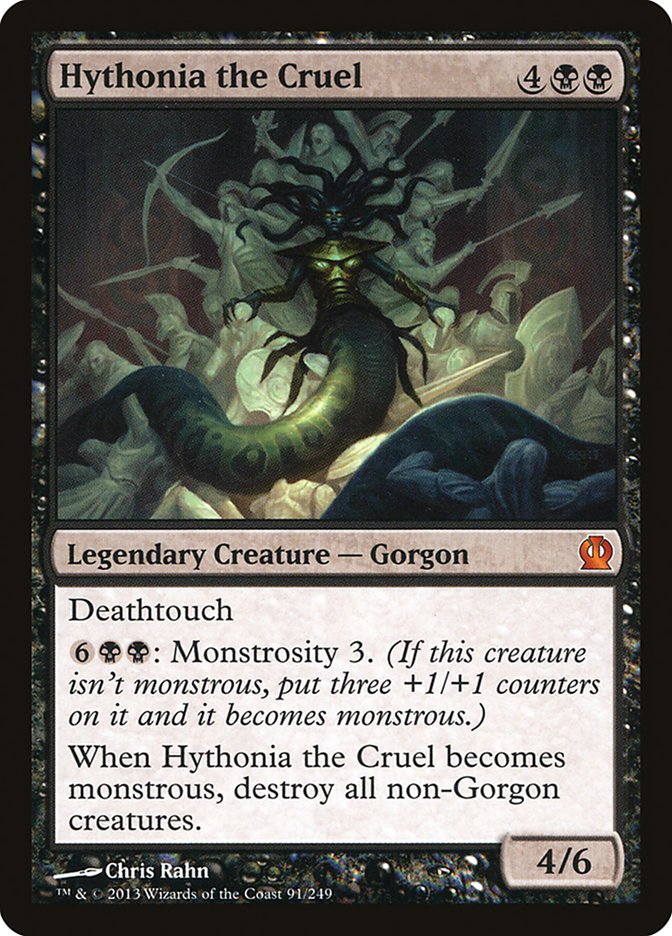Before we get started on Theros mythics, I want to talk a little about the following cards. These are the ten mythic rares that presold for more than $4 in Return to Ravnica. Take a look:
- Price at release: $40
- Current price: $6.29
- Price at release: $30
- Current price: $13.49
- Price at release: $15
- Current price: $2.24
- Price at release: $15
- Current price: $5.39
- Price at release: $15
- Current price: $5.39
- Price at release: $10
- Current price: $1.79
- Price at release: $10
- Current price: $5.39
- Price at release: $10
- Current price: $2.24
- Price at release: $8
- Current price: $1.34
- Price at release: $6
- Current price: $22.49
The other five mythics started close to bulk and stayed there all year, so I didn’t bother including them.
Granted, the StarCityGames.com Back To School Sale and the summer swoon have made some of these prices lower than they had been for most of the year. But after seeing those figures, you have to question the sanity of ever preordering expensive mythics. There’s a Sphinx’s Revelation situation every once in a while, but your odds of hitting the right sleeper aren’t very good. I preorder cards very rarely and always like to err on the side of trading away the things I open at the Prerelease as quickly as I can. I suggest that you do the same.
With that sobering reminder of the way, let’s take a look at the mythic rares of Theros!
The Gods
I already spent a full article covering these guys, so I’ll just briefly recap them here. All five Gods should see some play in Standard, though I doubt they will be the format-defining scourges that the M11 Titans were. Devotion is going to be much harder to hit and much less impactful than most people think, and I’m low on most devotion-dependent cards. Even still, I think the Gods are all playable even if you cannot hit their devotion bonuses with any regularity.
I think Purphoros and Erebos are a little overrated, though Purphoros is still quite possibly the best God. Nylea and Heliod are a little underrated, if only because they are in better devotion colors. Thassa is the best God in a vacuum, but hitting devotion to blue will require the furthest departure from playing a "normal" Magic deck.
Right now, all five Gods are benefiting from a price bump due to how cool they are. Players of all ages and skill levels will be thrilled to open these, and they will command a price and trade bonus roughly equal to the one that planeswalkers tend to enjoy. Even if the Gods don’t see much play right away, expect the prices to stay relatively high until the number of opened Theros packs reaches a saturation point and the "new car smell" goes away. That should happen by the time the next set comes out.
I cannot recommend preordering any of the Gods even though I like them all. While it is likely that one or two of them will maintain their value and become a tier 1 staple, their values across the board are simply too high right now to risk buying in. My predictions on these five cards are as close to guesses as any I have ever made and cover the short term only. Long term I really don’t know how good these things will end up being.
Fearless Prediction for Forge[/author]“]Purphoros, God of the [author name="Forge"]Forge[/author]: Tier 1 Standard staple. Price between $20 and $25.
Fearless Prediction for Thassa, God of the Sea: Tier 1 Standard staple. Price between $20 and $25.
Fearless Prediction for Nylea, God of the Hunt: Tier 2 Standard staple. Price between $10 and $15.
Fearless Prediction for Erebos, God of the Dead: Tier 2 Standard staple. Price between $10 and $15.
Fearless Prediction for Heliod, God of the Sun: Tier 2 Standard staple. Price between $10 and $15.
Xenagos, the Reveler – $39.99
- Will a R/G ramp deck exist in the format?
- If so, will Xenagos be the preferred four-drop?
- Does the card provide enough advantage to be useful outside of dedicated ramp decks?
Phew, let’s back to cards that I understand how to evaluate.
The first planeswalkers were some of the best utility cards in the history of the game. Jace Beleren doesn’t seem that overpowering in hindsight, but it was versatile enough to fit into nearly every deck running blue. Whether you were ramping or attacking, the original Garruk could help get the job done. Jace, the Mind Sculptor is probably the best example of this kind of planeswalker—no matter what your plan was, Jace would help further your goal.
Recent planeswalker design has become much narrower. This makes it much harder to evaluate planeswalkers during the preorder period. They’re often powerful enough to do one or two things very well, and if that strategy ends up being dominant, the card will end up seeing heavy play. If not, you’re looking at a near-term drop to $15 and a longer-term drop toward the $5-$10 range.
Xenagos is not very good if you’re not a dedicated ramp deck. The zero ability can stall, but paying four mana in order to stall out making 2/2s each turn is pretty weak. If you don’t have a bunch of early ramp creatures and big things to plop down, both of Xenagos’ other abilities are subpar as well. Xenagos is not powerful enough to simply slot into existing aggressive R/G decks.
Where Xenagos shines is in a dedicated ramp deck. So much of the time, those decks end up stalling out without enough ramp spells or enough big creatures to cast. Xenagos spends the first few turns helping you power stuff out, and after that he can give you a pseudo Genesis Wave to finish the job.
I have high hopes for Xenagos in Constructed because the strategy he enables is one that has historically been pretty good. As far as build-around-me flagships go, this is one of the better ones we’ve gotten recently. The problem is that the margin for error is tiny—if the ramp deck isn’t very good, Xenagos will hemorrhage value very quickly. I could see this deck doing very well straight off, which would shoot this guy’s price into the stratosphere (temporarily), but that’s the less likely of the two options. More likely Xenagos will be the flagship of a tier 2 deck that occasionally flashes tier 1 success. That should keep the card around $15 with spikes to $25 or $30. If the deck never materializes, this card will be $6-$7 next summer.
Fearless Prediction: Tier 2 Standard staple. Price between $15 and $25.
Elspeth, Sun’s Champion – $29.99
- Is this card powerful enough to justify paying six mana?
- Is this the finisher that white-based control decks will want to run?
The initial community reaction to Elspeth was muted, mostly from people who saw her casting cost and dismissed her immediately. We have had five planeswalkers cost six or more, though, and two of them—Garruk, Caller of Beasts and Karn Liberated—have seen some degree of competitive play.
The thing that I like best about Elspeth, Sun’s Champion is that she is good no matter what the board looks like. Facing down a bunch of tiny dorks? Make some Soldiers and get at least a two-for-one out of the deal. Facing down a lethal attack from giant monsters? Use Elspeth’s second ability to wipe the board. Board stall? Make Soldiers until you can go ultimate and win the game. As long as you can cast her, Elspeth will likely be one of the best cards you could hope to play regardless of how the game is currently going.
Control decks value versatility above all else. A card that can finish the game, stall the board, or sweep a bunch of creatures in one tidy package should not be dismissed lightly. Elspeth is the Theros planeswalker with the best chance to succeed and the one I suspect will make the biggest impact on Standard.
Fearless Prediction: Tier 1 Standard staple. Price between $20 and $35.
Ashiok, Nightmare Weaver – $24.99
- Will there be a good U/B control deck?
- Will it want to use this as a finisher?
- Will your opponents’ deck have enough creatures for this to reliably hit?
- Will the format be slow enough to let you wait a few turns to "hit" with Ashiok?
First off, let’s talk about why Ashiok might be very strong.
It only costs three mana to cast. Until now, there have been four three-mana planeswalkers: Domri Rade; Ajani, Caller of the Pride; Jace Beleren; and Liliana of the Veil. Three of the four have been among the best, most expensive, most powerful in Standard during their runs.
Ashiok can also win a game by itself. It does need to combo with your opponent’s deck, but it is rare to find a three-mana card that is capable of being a strong finisher on its own. This is the sort of "deal with me or die" threat that control decks like to sneak down and protect with countermagic and removal.
So yes, Ashiok is cheap and powerful. But will it be enough?
Let’s assume you’re playing a control deck against an aggro deck. On turn 3, you’re dropping Ashiok instead of killing one of their threats. You have to +2 it since that’s the only ability you can activate the turn you play it. It goes to five loyalty, and if you’re lucky you exile a mid-sized creature or two. On their turn, they can ignore Ashiok if you’ve missed or hit something small. If you hit something good, they come at him and knock his loyalty down enough so that you can’t cast the creature.
Second turn the best case is that you get to play something that can trade with one of their guys. Most of the time, though, you’re going to have to keep +2ing Ashiok and trying to hit anything at all. It’s not really going to help you stabilize much, but there are worse things you could have done with three mana.
Ashiok shines a little more once you’ve already established control. You should be able to get a couple of their creatures out with it, perhaps even saving up for one of their finishers if you get lucky enough to exile it. This is usually a win-more scenario, however, and I’m not sure how often it will come up.
In a control mirror, Ashiok has a little more staying power but a much smaller hit rate. You’re either using it to buy some of their utility creatures or hoping to eventually hit one of their Aetherlings or something. Unless control becomes significantly more creature based, I’m not sure Ashok will shine for you in these contests.
I don’t want to underrate a three-mana card that can finish the game, but it takes a while to get real card advantage out of this guy. You need to use your first turn to blindly exile stuff, probably your second as well, and then hope you’ve got enough loyalty left to summon a creature card that you have to hope you hit—and that’s just to get one card out of this guy. In the right environment Ashiok could become a powerhouse, but I’m not willing to preorder these at $25 each based on that small chance.
Fearless Prediction: Standard fringe player. Price between $7 and $12.
Stormbreath Dragon – $24.99
- How easy will it be to hit monstrosity in the decks that want to run this?
- How relevant will protection from white be?
- How relevant is the additional power and toughness on Thundermaw Hellkite versus this?
Let’s compare Stormbreath Dragon to a pair of other cards, both of which were Standard legal over the past year or so:
Mana cost: All three Dragons cost five mana to play. Hypersonic Dragon requires a blue mana. The others only need red.
Power and toughness: Thundermaw Hellkite is a 5/5. Hypersonic Dragon and Stormbreath Dragon are 4/4s.
Basic abilities: All three Dragons have flying and haste.
Secondary abilities: Hypersonic Dragon lets you play sorcery spells as though they were instants. Thundermaw Hellkite taps opposing flying blockers and kills one-toughness fliers like Lingering Souls tokens. Stormbreath Dragon has protection from white and a seven-mana monstrosity ability that punishes control decks.
Okay, it’s pretty clear that Hypersonic Dragon is the worst of the three. It requires blue mana, has the most situational ability, and only has a 4/4 body. It is also clear that Thundermaw Hellkite is the best—it’s the easiest to cast, it hits for the most damage, and its secondary abilities don’t require additional mana or cards to do what you want them to do.
What isn’t clear is where on the spectrum between these two cards Stormbreath Dragon sits. And considering Thundermaw Hellkite had a high of $40 and Hypersonic Dragon is a $0.50 bulk rare, it’s a pretty large spectrum indeed.
The downgrade from 5/5 to 4/4 is pretty big. We’ve yet to figure out what creatures will make the most impact in the new Standard, but chances are a 5/5 will win a fight with quite a lot more of them than a 4/4 will. Five damage is also one-fourth of an unblemished life total, which isn’t irrelevant.
Thundermaw Hellkite was very straightforward about what it was good at. If I played it and you didn’t counter it or throw removal at it, you were going to take five damage no matter what. It was a Lava Axe that threatened to go off every single turn. While the pro-white ability on Stormbreath Dragon might turn out to be excellent, it’s going to connect on the first turn much less often—and when it does it’ll deal less damage.
Stormbreath Dragon shines by giving you something good to do when you hit seven mana. At that point, you get to make your Dragon huge and deal your opponent somewhere between zero and seven damage. This will be a big game sometimes, but most of the decks that ran Thundermaw Hellkite didn’t want the game to get to this point and likely wouldn’t have run Stormbreath Dragon in that slot had it been around instead. I think the price on this card is being inflated due to an unfair comparison, and I suspect that if this card had been rare instead of mythic it wouldn’t be seeing so much praise.
Fearless Prediction: Standard fringe player. Price between $4 and $8.
Underworld Cerberus – $9.99
- Is this the finisher of choice for red/black or Jund decks?
- How effective will the pseudo-evasion end up being?
At first blush this card seems like a jumble of weird, disparate abilities. Is it an evasive finisher in a R/B deck? A reanimator hate card? A reanimator enabler? Why does the second ability seem to contradict the third, and why does the first seem like it belongs on a different card entirely? What does this card actually do?
Let’s start by assuming that the second two abilities are blanks for the moment and throw Cerberus in as the finisher in a pretty generic R/B deck. The Aristocrats doesn’t have Falkenrath Aristocrat, Hellrider, or Olivia Voldaren anymore, but I expect some sort of aggressive brew to survive, possibly with Exava, Rakdos Blood Witch and a bunch of red things with haste.
In a deck like that, Underworld Cerberus represents a threat that absolutely must be dealt with. It can’t be chumped or stopped by a big blocker—you have to kill it with a spell or already have some overwhelming board advantage. Assuming the control player is already on the back foot board-wise, as they usually are turn 5 against an aggro deck, their best bet is going to be just throwing a removal spell at it. Otherwise, they’ll be taking six a turn until they fall over.
Now let’s add the third ability back in. Once a control player zorches Cerberus with a removal spell, they cede a massive amount of card advantage back to the R/B mage. Unless the control player is playing with a higher than average number of bodies, the aggro player is going to get way more cards back than they are. Chances are that some of these cards are going to have haste, good abilities, or even bloodrush. Forget R/B—think about this guy in a Jund shell as a resilient, evasive threat that provides card advantage simply by dying. Now we’re cooking.
Building around Underworld Cerberus is a little harder but not impossible. It’s somewhat a nonbo with itself, disallowing you from reanimating any creatures while it’s in play. The better news is that it stops all graveyard hate while it’s on the battlefield, making it hard for your opponent to stop you from rebuying your creatures. Underworld Cerberus doesn’t help your dreams of reanimation—the creatures go back to your hand, not into play—but it does give those decks another way to utilize their spent threats.
Ultimately, you shouldn’t try to get cute with this big dog. Throw it in a shell with a bunch of dumb, resilient creatures that are already hard for control decks to get rid of and reap the rewards.
Fearless Prediction: Tier 1 Standard staple. Price between $10 and $20.
Master of Waves – $9.99
- How easy will it be to build up a large devotion to blue?
- How much nonred removal will be played in Standard?
- Will a blue deck with a lot of permanents in play want to run this either as a finisher or a midrange value creature?
My first ever Champions of Kamigawa draft was during a house party in high school. It was late at night, and none of us were all that familiar with the set, Limited play, or card evaluation in general.
My friend Alex ended up with a combo that ended up taking down the entire draft: Junkyo Bell and Meloku, the Clouded Mirror. The Bell was a very late pick, and we were all in awe that the card had done so much work. "Oh man," he told us. "Junkyo Bell is so much better than you think!"
Nope. Junkyo Bell is terrible. Meloku, however, is one of the best cards ever printed. Not only was it a major Draft bomb, but it was the blue finisher of choice in Standard over the next year. I ended up playing with a lot of Meloku decks, and it’s one of my all-time favorite cards.
Master of Waves, you are no Meloku. You know what you need to have in play for Meloku to be good? Lands. Yeah, you’re probably going to have a cartload of those just by playing the game of Magic. Even better, Meloku can finish the game even if your opponent kills it—just scoop up your untapped mana base and make a pile of tokens.
Master of Waves needs a lot more to go his way. First, you need to have a large devotion to blue. If some sort of weird blue Thassa-based midrange deck develops, I can see this being good, but it would have to be different than pretty much every other blue deck ever made. Second, the creatures are only good if the Master lives or you have another anthem effect out. If either one of these conditions isn’t met, you can dispatch the Elementals simply by Doom Blading their Master.
I don’t want to dismiss this card out of hand, however, because his upside is immense. If you do have a high devotion to blue when you play it and they can’t immediately kill it, your four-drop has just given you a whole pile of creatures. That’s super valuable. Even if you devotion to blue is minimal—say, two blue mana symbols plus the Master himself—you’re getting eight power on the board for four mana. That’s approaching the sort of efficiency shared by the best white token generators and green beaters. Granted, you’re not going to want to attack with the Master himself, but the 2/1 bodies are far better than the 1/1s that most token-generating cards make.
If Thassa, God of the Sea is good, there’s a realistic chance that this card ends up being quite good as well. It’s going to require a totally different type of blue deck than we’ve seen in quite a while, though, and if the devotion strategy doesn’t pan out, this will end up as a bulk mythic quite quickly. I’m going to hedge a bit and say this is a future tier 2 card in Standard, but pay it very close mind. This is likely either a $2 rare or the next Sphinx’s Revelation.
Fearless Prediction: Tier 2 Standard staple. Price between $4 and $8.
Medomai the Ageless – $7.99
- How easy will it be to deal combat damage with a 4/4 flier?
- Is this a biting control finisher or just a combo piece?
- Is this good enough as a tier 1 reanimation target?
The last time Time Warp was in Standard, it didn’t see much play. Taking extra turns is quite powerful, but five mana is a lot to spend for the privilege. A lot of times it’s easier and more efficient to get ahead on the board in other ways—spells that draw multiple cards, accelerate your mana base, or plop a bunch of creatures into play at once.
Medomai isn’t quite Time Warp. If you can’t swing in with it, it’s just a 4/4 flier for six—decidedly behind the curve. Hypersonic Dragon comes to mind yet again. The good news is that if you can get in with Medomai once, there’s a very good chance it’ll take the game over from there. You get two turns for each one your opponent gets until they find removal for Medomai.
This is going to happen, but it’s going to be on kitchen tables, not at Constructed tournaments. 6CC creatures that don’t do anything the turn they come into play just aren’t very good most of the time. The best one in recent memory—Consecrated Sphinx—was a 6/6 that drew you a pair of guaranteed cards on your opponent’s draw step if you played it against a tapped-out board. Medomai is certainly powerful if you get it going, but it’s a dead draw way too much of the time.
Fearless Prediction: Casual all-star – $3-$5.
Polukranos, World Eater – $7.99
- How good is a 5/5 for 4 going to be in the new Standard?
- Will there be a green devotion deck?
- Will ramp decks be able to get their mana big enough to use this as a removal spell?
First off, make sure you read the monstrosity on this guy correctly because it isn’t very intuitive at first glance. Let’s assume you have eight mana to spend making this guy monstrous. The cost is XXG, so in this case X would be three. That turns Polukranos into an 8/8 and lets you deal three damage divided among your opponents’ creatures. Best case, you can nab a utility creature or two. That’s fine—it’s a nice two-for-one—but it’s not going to be relevant in a lot of situations.
Okay, so you’re not exactly paying for that monstrosity ability—good thing it comes stapled to a 5/5 Hydra that isn’t too shabby in its own right. A 5/5 for four isn’t very playable on its own—that’s Imperiosaur—but it’s still on curve for what a green deck is trying to accomplish. Dropping this on turn 3 or 4 is still presenting a decent threat, and Polukranos also gets you two-fifths of the way to unlocking Nylea. The fact that Nylea gives Polukranos trample isn’t irrelevant either—that’s exactly what this Hydra needs in order to be good.
Polukranos seems worth considering as a midrange play in a ramp deck as well as a reasonable threat in some sort of mono-green devotion brew. The card certainly isn’t overpowered, but giving your cheap, giant dork a second life as a removal spell is enough for me to believe that this guy will see some play. You don’t have to be an all-star to make the cut in Standard—you just have to offer something that fits into a winning strategy.
Fearless Prediction: Tier 2 Standard staple. Price between $6 and $10.
Ashen Rider – $7.99
- Does this card serve a different enough purpose than Blood Baron of Vizkopa or Obzedat, Ghost Council in an Orzhov control shell?
- Is any sort of reanimator deck going to be viable in Standard?
- Is this card too hard to cast?
Playing an eight-drop is hard enough, but casting a creature for 4WWBB is nearly impossible. Assuming that the ramp deck is based in green and red, your mana fixing would have to be excellent to even think about running Ashen Rider with the intent to cast it fairly.
As a simple control finisher, Ashen Rider pales in comparison to Obzedat and Blood Baron. Both are cheaper, easier to cast, and do a perfectly good job ending the game by themselves. No—for this card to work, it has to be in some sort of Whip of Erebos and/or Rescue from the Underworld deck. The biggest thing holding the card back right now is the lack of good ways to discard reanimator targets for value. Liliana of the Veil isn’t walking through that door.
While casual and Eternal playability aren’t much of a factor in evaluating the price of rares, mythics can hold value due to these factors alone. In fact, it has been happening more and more. The thing I like about Ashen Rider is that it is pretty much a strict upgrade over Angel of Despair for those who would consider running that card. Ashen Rider isn’t an Angel, which does hurt it from a casual perspective, but people really like powerful and versatile answers.
The bottom line is that this card carries an excellent pedigree and appeals to each of the three psychographics. Because of that, I see it maintaining value for years. If a reanimator deck doesn’t emerge, look for it to drop toward $5 before a steady climb towards $10 next year. If it does, this card should be steady in the $12-$15 range.
Fearless Prediction: Tier 2 Standard staple. Price between $6 and $10.
Hythonia the Cruel – $3.99
- Will a mono-black ramp deck exist?
- If so, will it be able to hit the monstrosity cost with any regularity?
For all intents and purposes, Hythonia costs eight, not six—the 4/6 body with deathtouch isn’t doing anyone any favors in Constructed Magic. Even worse, she costs a whopping fourteen mana if you want to play her and sweep the board in one turn. Even the biggest devotees of Nykthos don’t seem to believe that hitting fourteen in a normal game of Magic is that realistic.
If you do get to fourteen mana, you end up with a 7/9 Gorgon versus an empty board, which is pretty sweet. If I ever build a mono-black big-mana Commander deck, Hythonia will find her way in for sure. I can’t see this ever seeing play in a competitive format though.
Fearless Prediction: Bulk mythic, the only one in the set. $2.
Uncommons and Commons of Note
Magma Jet – This card was a staple last time around, and nothing has changed. It should hit $1 once a bunch of packs get opened, but it’s a solid $2 staple long term. It could hit $3-$4 on the floor before a big event.
Pharika’s Mender – A solid casual/Commander card. Keep it out of your bulk pile.
Rescue from the Underworld – I think this is Standard playable and could hit $2-$3 if the deck ends up being good.
Destructive Revelry – As the block goes on, this card will keep getting better.
Dissolve – Block counterspells tend to stay between $1 and $2 while they’re legal. This will be no exception.
Karametra’s Acolyte – This is the sort of card that ends up being $1-$2 a few years after the set comes out, stunning everyone who figured it was bulk the whole time.
Nemesis of Mortals – There’s some hype around this one, but it seems a bit clunky to me.
Spellheart Chimera – I don’t know if this is good enough to make it, but on paper it’s a heck of a finisher in the right deck. The trample is amazing, and three toughness isn’t bad either. It doesn’t take much to make this card very good.
Tormented Hero – Diregraf Ghoul was a $2 card for a while. This isn’t a Zombie, but it does have upside.
Lightning Strike – This common should trade well until people get their playsets. If you opened any at the Prerelease, see if you can swap them for a couple of bulk rares. It should hold reasonable value for a common over the long term as well.
My Picks
Best Mythic Of The Set: Elspeth, Sun’s Champion
Sleeper Mythic Of The Set: Underworld Cerberus (as much as there is any—they’re all expensive)
Bust Mythic Of The Set: Stormbreath Dragon
Best Rare Of The Set: Thoughtseize
Sleeper Rare Of The Set: Fabled Hero
Bust Rare Of The Set: Swan Song
Favorite Card: Prophet of Kruphix
Card I’m Most Out On A Limb For Believing In: Daxos of Meletis
Popular Cards(s) I’m Lowest On: Stormbreath Dragon; Nykthos, Shrine to Nyx; Xenagos, the Reveler
Highest Variance Card(s): All five Gods, Master of Waves, devotion in general
Spec Portfolio – Week #5
We’ve still got one more week of the StarCityGames.com Back To School Sale, which means no selling. Luckily, there’s no real need to. Card values have started to rebound nicely, and other than some fluctuation on the price of Thespian’s Stage, it was another awesome week for us. Take a look:
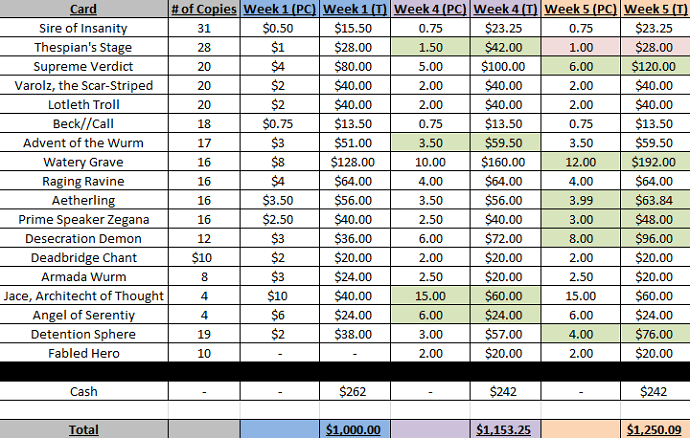
We aren’t quite in the black—selling everything today would leave us about 60 bucks short of recouping our investment—but our slow and steady gains have been nice to see. We’ve got some additional value hiding in the Jaces as well, which will undoubtedly be more expensive when they’re restocked. So far so good!
Until next week –
– Chas Andres

